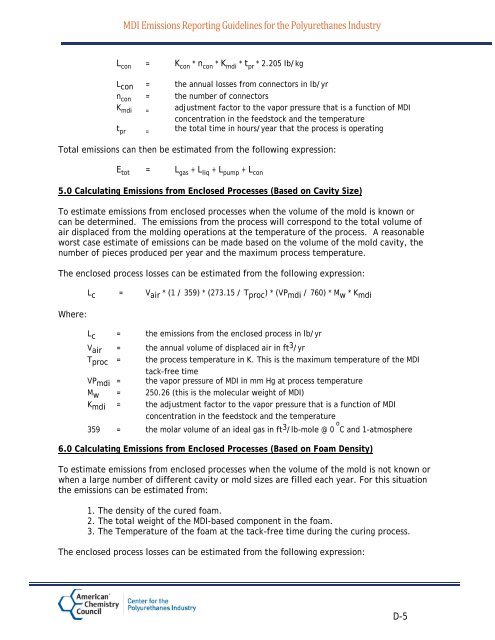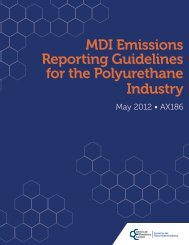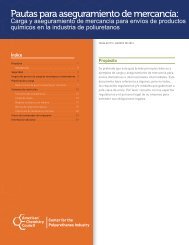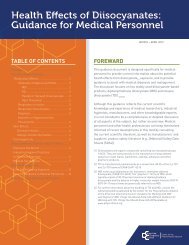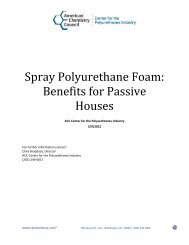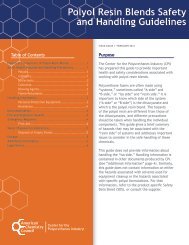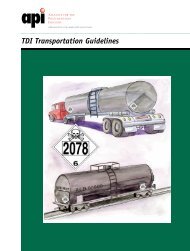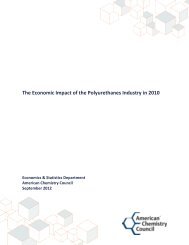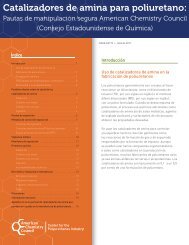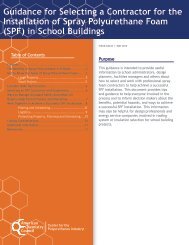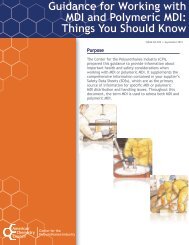MDI Emissions Reporting Guidelines for the ... - Polyurethanes
MDI Emissions Reporting Guidelines for the ... - Polyurethanes
MDI Emissions Reporting Guidelines for the ... - Polyurethanes
Create successful ePaper yourself
Turn your PDF publications into a flip-book with our unique Google optimized e-Paper software.
<strong>MDI</strong> <strong>Emissions</strong> <strong>Reporting</strong> <strong>Guidelines</strong> <strong>for</strong> <strong>the</strong> <strong>Polyurethanes</strong> Industry<br />
L con = K con * n con * K mdi * t pr * 2.205 lb/kg<br />
Lcon = <strong>the</strong> annual losses from connectors in lb/yr<br />
ncon = <strong>the</strong> number of connectors<br />
Kmdi = adjustment factor to <strong>the</strong> vapor pressure that is a function of <strong>MDI</strong><br />
concentration in <strong>the</strong> feedstock and <strong>the</strong> temperature<br />
tpr = <strong>the</strong> total time in hours/year that <strong>the</strong> process is operating<br />
Total emissions can <strong>the</strong>n be estimated from <strong>the</strong> following expression:<br />
E tot = L gas + L liq + L pump + L con<br />
5.0 Calculating <strong>Emissions</strong> from Enclosed Processes (Based on Cavity Size)<br />
To estimate emissions from enclosed processes when <strong>the</strong> volume of <strong>the</strong> mold is known or<br />
can be determined. The emissions from <strong>the</strong> process will correspond to <strong>the</strong> total volume of<br />
air displaced from <strong>the</strong> molding operations at <strong>the</strong> temperature of <strong>the</strong> process. A reasonable<br />
worst case estimate of emissions can be made based on <strong>the</strong> volume of <strong>the</strong> mold cavity, <strong>the</strong><br />
number of pieces produced per year and <strong>the</strong> maximum process temperature.<br />
The enclosed process losses can be estimated from <strong>the</strong> following expression:<br />
Where:<br />
L c = V air * (1 / 359) * (273.15 / T proc ) * (VP mdi / 760) * M w * K mdi<br />
Lc = <strong>the</strong> emissions from <strong>the</strong> enclosed process in lb/yr<br />
Vair = <strong>the</strong> annual volume of displaced air in ft3 /yr<br />
Tproc = <strong>the</strong> process temperature in K. This is <strong>the</strong> maximum temperature of <strong>the</strong> <strong>MDI</strong><br />
tack-free time<br />
VPmdi = <strong>the</strong> vapor pressure of <strong>MDI</strong> in mm Hg at process temperature<br />
Mw = 250.26 (this is <strong>the</strong> molecular weight of <strong>MDI</strong>)<br />
Kmdi = <strong>the</strong> adjustment factor to <strong>the</strong> vapor pressure that is a function of <strong>MDI</strong><br />
concentration in <strong>the</strong> feedstock and <strong>the</strong> temperature<br />
359 = <strong>the</strong> molar volume of an ideal gas in ft3 /lb-mole @ 0 o<br />
C and 1-atmosphere<br />
6.0 Calculating <strong>Emissions</strong> from Enclosed Processes (Based on Foam Density)<br />
To estimate emissions from enclosed processes when <strong>the</strong> volume of <strong>the</strong> mold is not known or<br />
when a large number of different cavity or mold sizes are filled each year. For this situation<br />
<strong>the</strong> emissions can be estimated from:<br />
1. The density of <strong>the</strong> cured foam.<br />
2. The total weight of <strong>the</strong> <strong>MDI</strong>-based component in <strong>the</strong> foam.<br />
3. The Temperature of <strong>the</strong> foam at <strong>the</strong> tack-free time during <strong>the</strong> curing process.<br />
The enclosed process losses can be estimated from <strong>the</strong> following expression:<br />
D-5


